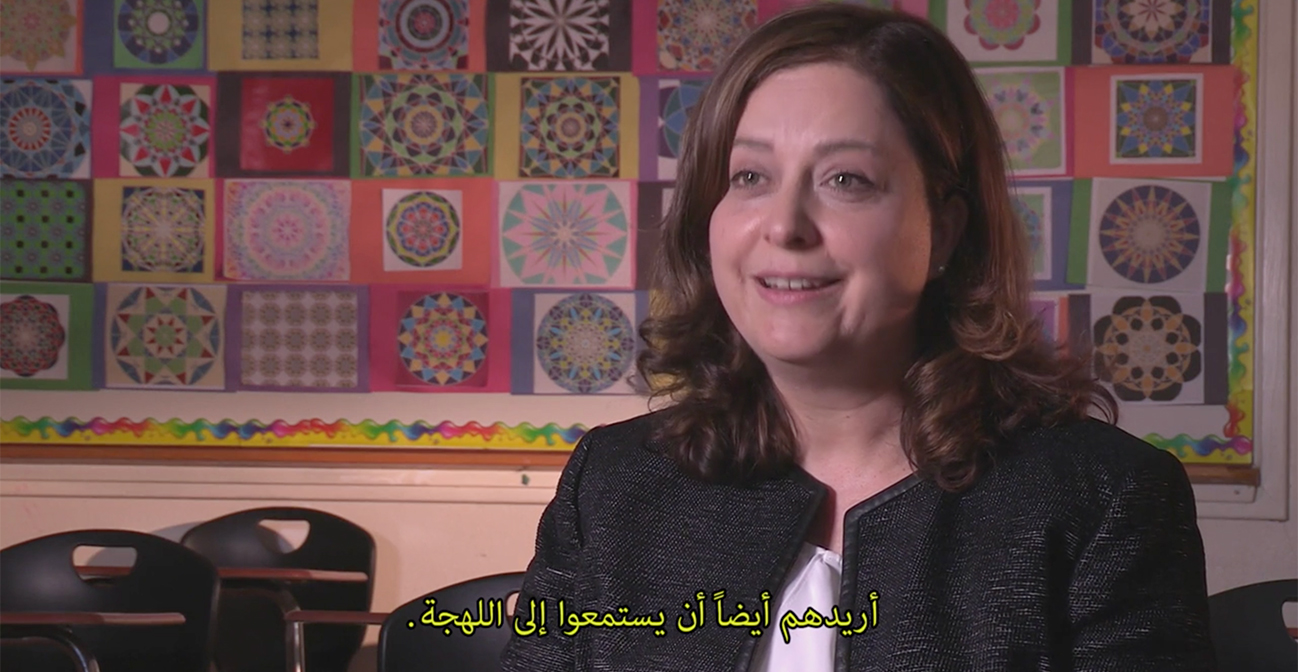Join us for conversations that inspire, recognize, and encourage innovation and best practices in the education profession.
Available on Apple Podcasts, Spotify, Google Podcasts, and more.

CLASSROOM AT A GLANCE
Teacher
Manar Mayalah
Language
Arabic II and III
Grades
9 and 10
School
Granada Hills Charter School, Los Angeles, California
Lesson Date
March 10
Class Size
22 (filmed with 12)
Schedule
55 minutes daily
اضغط هنا للترجمة باللغة العربية
In this lesson, students learn vocabulary used to describe the rooms and exterior features of houses, including their own dream houses. Ms. Mayalah introduces the day’s lesson by playing music for the class in which Lebanese singer SabaaH sings about her “dear little house.” After reviewing the class agenda with the students, Ms. Mayalah shows videos of a traditional house in Syria and Lebanese singer Nancy Ajram’s modern house in Lebanon, and introduces vocabulary to describe the features of each house. Next, students work in pairs to complete a sentence-strip activity, choosing whether a written description describes the traditional house or the modern one. Students use worksheets to write descriptions of their own dream houses and interview one another about their dream houses. They then present their descriptions orally and without using their notes to the entire class.
Communication: Interpersonal, Presentational
Cultures: Products
Comparisons: Cultural
heritage speaker
A heritage speaker is a student who is exposed to a language other than English at home. Heritage speakers can be categorized based on the prominence and development of the heritage language in the student’s daily life. Some students have full oral fluency and literacy in the home language; others may have full oral fluency but their written literacy was not developed because they were schooled in English. Another group of students — typically third- or fourth-generation — can speak to a limited degree but cannot express themselves on a wide range of topics. Students from any of these categories may also have gaps in knowledge about their cultural heritage. Teachers who have heritage speakers of the target language in their class should assess which proficiencies need to be maintained and which need to be developed further. See also native speaker.
realia
Realia are materials that are highly visual, contextualized, and culturally authentic. Realia can include posters, advertisements, labels, schedules, tickets, placemats, and more.
thematic units
Thematic units are designed using content as the organizing principle. Vocabulary, structures, and cultural information are included as they relate to the themes in each unit.
As you reflect on these questions, write down your responses or discuss them as a group.
Watch other videos in the Teaching Foreign Languages K–12 library for more examples of teaching methodologies like those you’ve just seen. Note: All videos in this series are subtitled in English.
Try these ideas in your classroom. Where it’s not already evident, reflect on how to adapt an idea that targets one performance range for application to other performance ranges.
World-Readiness Standards for Learning Languages
The World-Readiness Standards for Learning Languages create a roadmap to guide learners to develop competence to communicate effectively and interact with cultural understanding. This lesson correlates to the following Standards:
Interpersonal Communication
Presentational Communication
Relating Cultural Products to Perspectives
Cultural Comparisons
اضغط هنا للترجمة باللغة العربية
Your Dream House (PDF)
A worksheet used to accompany the speaking and writing activity in which students discuss with a partner and then draw their dream house
“Damascus’s Beauty”
A YouTube video showing the interior of a traditional house in Damascus
“Nancy Ajram’s House in Lebanon”
A YouTube video showing the interior and exterior of singer Nancy Ajram’s house in Lebanon
Sentence Strip Activity (PDF)
Comparison questions and sentence strips used in the matching activity
Manar Mayalah’s Additional Resources
Web Resources:
Aswaat cArabiyya
Listening materials for the various levels of proficiency
Al-Hakawati
Reading materials on a wide variety of themes, including Arab countries and cities, and famous writers throughout Arab history